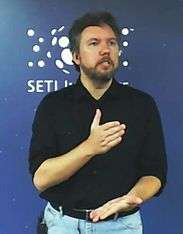Stephen R. Kane
| Stephen Kane | |
|---|---|
|
Stephen Kane speaking at the Search for Extraterrestrial Intelligence (SETI) Institute in Mountain View, July 22, 2014. | |
| Born | October 25, 1973 (age 43) |
| Nationality | Australian |
| Occupation | Astrophysicist |
Stephen Kane is an associate professor of astronomy at San Francisco State University who specializes in exoplanetary science. His work covers a broad range of exoplanet detection methods, including the microlensing, transit, radial velocity, and imaging techniques. He is a leading expert on the topic of planetary habitability and the habitable zone of planetary systems. He has published more than 180 scientific papers in refereed journals and has discovered/co-discovered several hundred planets orbiting other stars.
Education
Kane graduated from Macquarie University with a Bachelors of Science in Physics in 1994. In 1995 Kane received First Class with Honors at the same institution for his work studying a galactic extended source, which he identified as a previously unknown supernova remnant.[1] In 2000 Kane received his Ph.D. from the University of Tasmania with a thesis focusing on gravitational microlensing,[2] the bending of space by gravity which has a variety of astrophysics applications, including the discovery of exoplanets.
Career
During his graduate degree, Kane had the title of research assistant at the Space Telescope Science Institute in 1996. After graduating, Kane joined the University of St. Andrews in 2001 as a postdoctoral research fellow,[3] he collaborated with a team of scientists that discovered the coldest, smallest known exoplanet (OGLE-2005-BLG-390Lb), confirming the hopes that observation of habitable planets was within the reach of technology[7]. Kane and the entire SuperWASP (Super Wide Angle Search for Planets) team was later awarded the Royal Astronomical Society's Group Achievement Award in 2010[4][5] for their discovery of 18 exoplanets. In 2005 he returned to the United States to work as a postdoctoral associate at the University of Florida[6] where he discovered some of the hottest known exoplanets of the time.[7] In 2008 Kane became a research scientist at the NASA Exoplanet Science Institute (NExScI) at the California Institute of Technology (Caltech) where he focused his research on exoplanet habitability, the study of properties and conditions favorable to life. While at Caltech he and collaborator Dawn Gelino created the Habitable Zone Gallery,[8] a website dedicated to providing information on exoplanets for both scientists and the general public. Kane joined San Francisco State University in 2013 and was promoted to Associate Professor in 2016. In August 2016, Kane and collaborators released the "Catalog of Kepler Habitable Zone Exoplanet Candidates", identifying numerous Habitable Zone planets discovered by the Kepler mission.[9]
Media Attention
- 2017 - Nearby Solar System Wolf 1061 May Be The Key To Understanding Venus-like Worlds[10]
- 2016 - The 20 Most Earth-Like Exoplanets We've Found[11]
- 2016 - Endor's End: How the 'Star Wars' Death Star Wiped Out the Ewoks After All[12]
- 2016 - Most eccentric planet ever known flashes astronomers with reflected light[13]
- 2016 - This Is The ‘Most Eccentric’ Planet Yet Known[14]
- 2015 - Beloved Star Wars Worlds[15]
- 2015 - Newly discovered exoplanet orbits a pair of stars[16]
- 2015 - UC Berkeley astronomer Geoffrey Marcy's sexual harassment scandal[17]
- 2015 - New ‘Tatooine’ Discovery Confirms Circumbinary Planets Aren’t Just Science Fiction[18]
- 2015 - Tales from the Superbowl of Astronomy[19]
- 2014 - Science consultant for Sid Meier's Civilization video game[20][21]
- 2012 - Life can survive on eccentric planets (CBS,[22] NASA[23])
- 2012 - Space Telescope Finds 100 Billion Alien Worlds in Milky Way
- 2004 - BBC television series The Sky at Night episode titled Planet Quest[24]
References
- ↑ Kane, Stephen. "Radio observations of the supernova remnant candidate G312.5-3.0".
- ↑ Kane, Stephen (2000-01-01). "A Spectroscopic and Photometric Study of Gravitational Microlensing Events".
- ↑ "Group Members | Astronomy Group". star-www.st-andrews.ac.uk. Retrieved 2016-06-28.
- ↑ Webmaster. "RAS Honours Outstanding Astronomers and Geophysicists". www.ras.org.uk. Retrieved 2016-06-28.
- ↑ "Group Achievement Award". www.st-andrews.ac.uk. Retrieved 2016-06-28.
- ↑ "Team Members". www.astro.ufl.edu. Retrieved 2016-06-28.
- ↑ Florida, University of. "09 » Astronomers discover two new planets, both among the hottest ever » University of Florida". news.ufl.edu. Retrieved 2016-06-28.
- ↑ "The Habitable Zone Gallery". hzgallery.org. Retrieved 2016-06-28.
- ↑ Kane, Stephen. "A Catalog of Kepler Habitable Zone Exoplanet Candidates".
- ↑ "Nearby Solar System Wolf 1061 May Be The Key To Understanding Venus-like Worlds". Retrieved 2017-01-26.
- ↑ "The 20 Most Earth-Like Exoplanets We've Found". Retrieved 2016-08-03.
- ↑ "Endor's End: How the 'Star Wars' Death Star Wiped Out the Ewoks After All". Retrieved 2016-06-28.
- ↑ "Most eccentric planet ever known flashes astronomers with reflected light". sciencedaily.com. Retrieved 2016-06-28.
- ↑ Jacqueline Howard Senior Science Editor, The Huffington Post (2016-03-24). "This Is The 'Most Eccentric' Planet Yet Known". The Huffington Post. Retrieved 2016-06-28.
- ↑ "See the 'Star Wars' Worlds Exoplanet Scientists Can't Help But Love". Retrieved 2016-06-28.
- ↑ "Newly discovered exoplanet orbits a pair of stars". Washington Post. Retrieved 2016-06-28.
- ↑ "Allegations tie Berkeley sexual assault scandal to SF State". Golden Gate Xpress. 2015-10-21. Retrieved 2016-06-28.
- ↑ Chris D'Angelo Associate Editor, HuffPost Hawaii (2015-08-14). "New 'Tatooine' Discovery Confirms Circumbinary Planets Aren't Just Science Fiction". The Huffington Post. Retrieved 2016-06-28.
- ↑ "Tales From the Superbowl of Astronomy". Phenomena. 2015-01-12. Retrieved 2016-06-28.
- ↑ "Discovering the New Beginning". franchise.civilization.com. Retrieved 2016-06-28.
- ↑ "Astronomer Reveals The Truth Behind Civilization: Beyond Earth's Exoplanets". Retrieved 2016-06-28.
- ↑ "NASA: Wide range of alien planets may support life". Retrieved 2016-06-28.
- ↑ "NASA - Extreme Life Forms Might be Able to Survive on Eccentric Exoplanets". www.nasa.gov. Retrieved 2016-06-28.
- ↑ "Planet Quest, The Sky at Night - BBC Four". BBC. Retrieved 2016-06-28.
